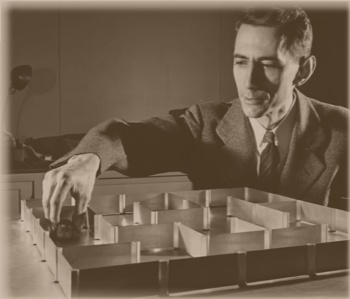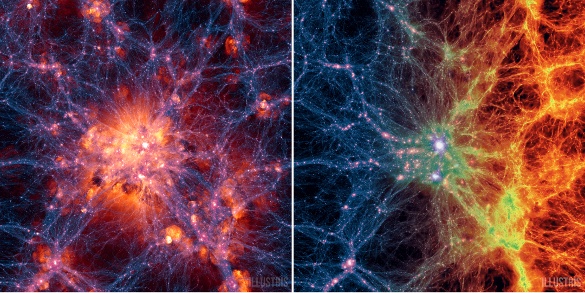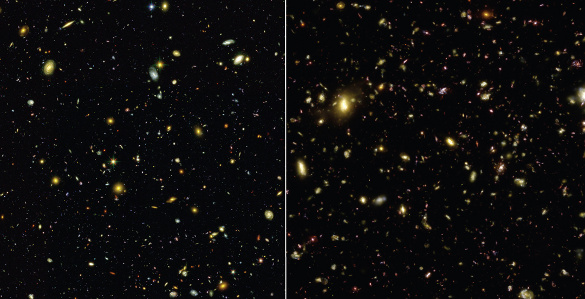Simulating the Universe
May 21, 2014
In a
previous article (Our Simulated Universe, January 2, 2013), I examined the idea that we might be inhabitants of a
computer simulation. The old
adage, "
If all you have is a hammer, everything looks like a nail," now codified as the
Law of the Instrument, might apply here. Since we've just discovered
information theory and are into our early years with
computers, we might have a tendency to think that everything is information, and information is best processed by computers.

I've always liked this image of Claude Shannon, the founder of information theory, demonstrating maze-solving by a mechanical mouse.
(Still image from a YouTube video by BinarycoreMedia, April 30, 2013, modified for artistic effect.)
A computer powerful enough to simulate our entire
universe would be quite a computer, indeed! The whole thing seems fantastic. However, we can see how far computing has progressed in the last half
century, so we would be shortsighted to dismiss the idea that the universe is a simulation without giving it some thought. If the
technological singularity does arrive in the next few
decades, whatever
intelligence survives after that point might be able to simulate sizable universes
willy-nilly a short time later.
Theoretical physicists are able to simulate small pieces of our universe, up to about 10
-14 meter in size, or 10
20 Planck lengths (1.6 x 10
-35 meter). Simple
molecules of
chemical compounds such as
methane are a few tenths of a
nanometer in size, we're within a few
orders of magnitude from simulating those.[1] The next step up would be
viruses and
biological cells.
Would it be possible for us to determine whether we are living in a simulation? In 2012,
physicists from the
University of Washington and the
Universität Bonn, suggested that any such simulation would have its limits. The
highest energy cosmic rays have an energy of 10
11 GeV, so we should look at the
distribution of the highest energy cosmic rays for
anomalies.[2-3]
Such bottom-up simulations will capture every nuance of physical reality, but we're often just interested in what we can glean from some broad strokes. That's why we have such tools as the
finite element method, which divides objects into a much coarser
grid than the Planck length, but still gives us an idea whether our
bridge will endure, collapse under its own
weight, or as the
result of environmental affects.
The
Illustris simulation is a joint project of
scientists from the
Massachusetts Institute of Technology (Cambridge, Massachusetts), the
Harvard-Smithsonian Center for Astrophysics (Cambridge, Massachusetts), the
Heidelberg Institute for Theoretical Studies (Heidelberg, Germany), the
Zentrum für Astronomie der Universität Heidelberg (Heidelberg, Germany), the
Kavli Institute for Cosmology (Cambridge, UK), the
Space Telescope Science Institute (Baltimore, Maryland) and the
Institute for Advanced Study (Princeton, New Jersey). Its object, the simulation of
galaxy formation in the universe, was completed in late 2013, and its results have been recently reported.[4-10]
Through a comprehensive physical model and quite a bit of computation, this simulation has achieved high resolution simulations of large
volumes of
space that agree favorably with physical reality. It's an advance over previous simulations that didn't create the proper mix of
elliptical and
spiral galaxies.[4-5]
The Illustris simulation starts 12 million years after the
Big Bang, and it reproduces 13.8
billion years of cosmic evolution with 12 billion resolution elements in a cube of 106.5
megaparsecs (350 million
light-years) on a side. Along with its reproducing the proper mix of elliptical and spiral galaxies, Illustris reproduces the observed distribution of galaxies in
clusters, the
density of
hydrogen on large scales, and the hydrogen content of galaxies on small scales.[4-5]
The Illustris simulation includes normal matter and
dark matter, and its calculations are on 12 billion
voxel (volume pixel) elements.[6] Such high resolution allows the Illustris data to be presented visually, so it can be compared with actual
astronomical observations.[7]
Program development occurred over the course of five years, with the actual computation taking somewhat less than six months on a variety of
supercomputers.[6,9]

Left image, a still frame from the Illustris simulation, centered on the most massive galactic cluster known today. The blue-purple filaments show the location of dark matter, while the red, orange and white regions are areas of gas. Right image, an expanded view of the central area of the left image. (Illustris simulation images)[6)]
Computers used for the Illustris simulation were the
Harvard Odyssey and
CfA/ITC cluster; the
Ranger and Stampede supercomputers at the
Texas Advanced Computing Center; the
CURIE supercomputer at CEA/France; and the
SuperMUC computer at the
Leibniz Computing Centre in
Germany.[7] These calculations would have taken more than 2,000 years to complete on a typical
home computer.[6,8-9]
Starting from an
initial condition for a universe twelve million years after the Big Bang, the Illustris simulation proceeds to the present day, 13.8 billion years later. The simulation volume contained 41,416 galaxies at the end, with galactic development closely following what's observed. The simulation recreated the observed mix of spiral and elliptical galaxies, as well as the occurrence of galactic clusters,
bubbles and
voids.[6-7]

Illustris image (right) compared with an actual observation by the Hubble Space Telescope (left). The sizes, types, and colors of galaxies are closely simulated. (Images: NASA / Illustris Collaboration.)
Dark matter figures prominently in the Illustris calculations. Over the course of the simulation, dark matter
coalesces to seed the first galaxies.[8]
Mark Vogelsberger, an
assistant professor of
physics at MIT and principal author of the article in
Nature describing the simulation, is quoted by
BBC News as saying, "If you don't include dark matter, it will not look like the real Universe."[8]
Although the Illustris simulation gives results that amazingly mirror reality, its creators still see a need for improvement. Says Vogelsberger, "Low-mass galaxies just form too early in the simulation... so the stars are too old compared to the ones in the real universe."[7,9]
A
high-definition video of the simulated
evolution of the universe is available online at the Illustris Web Site (
http://www.illustris-project.org).[6] Other researchers are welcome to the data, but there's a small
technical problem. These data would take months to
download, even with a fast
Internet connection. The Illustris simulation was funded by the
German Research Foundation, the
European Research Council,
NASA, and the
Alexander von Humboldt Foundation.[7]
References:
- Note that this a priori simulation is different from molecular orbital theory, which is routinely practiced by chemists.
- Vince Stricherz, "Do we live in a computer simulation? UW researchers say idea can be tested," University of Washington Press Release, December 10, 2012.
- Silas R. Beane, Zohreh Davoudi and Martin J. Savage, "Constraints on the Universe as a Numerical Simulation," arXiv Preprint Server, November 9, 2012.
- M. Vogelsberger, S. Genel, V. Springel, P. Torrey, D. Sijacki, D. Xu, G. Snyder, S. Bird, D. Nelson and L. Hernquist, "Properties of galaxies reproduced by a hydrodynamic simulation," Nature, vol. 509, no. 7499 (May 8, 2014), pp. 177–182.
- M. Vogelsberger, S. Genel, V. Springel, P. Torrey, D. Sijacki, D. Xu, G. Snyder, S. Bird, D. Nelson and L. Hernquist, "Properties of galaxies reproduced by a hydrodynamic simulation," arXiv Preprint Server, May 6, 2014.
- Astronomers Create First Realistic Virtual Universe, Harvard-Smithsonian Center for Astrophysics Press Release No. 2014-10, May 7, 2014.
- Peter Dizikes, "The universe in a cube," MIT Press Release, May 7, 2014.
- Pallab Ghosh, "Universe evolution recreated in lab," BBC News, May 7, 2014.
- Ian Sample, "Universe recreated in massive computer simulation," The Guardian (UK), May 7, 2014.
- The Illustris Simulation Web Site.
Permanent Link to this article
Linked Keywords: Computer simulation; adage; If all you have is a hammer, everything looks like a nail; Law of the Instrument; information theory; computer; Claude Shannon; maze; mouse; YouTube; BinarycoreMedia; universe; century; technological singularity; decade; intelligence; arbitrariness; willy-nilly; theoretical physicist; meter; Planck length; molecule; chemical compound; methane; nanometer; orders of magnitude; virus; biological cell; physicist; University of Washington; University of Bonn; Universität Bonn; ultra-high-energy cosmic ray; electronvolt; GeV; distribution; anomaly; finite element method; lattice graph; grid; bridge; weight; Tacoma Narrows Bridge; environmental affect; Illustris simulation; Massachusetts Institute of Technology (Cambridge, Massachusetts); Harvard-Smithsonian Center for Astrophysics (Cambridge, Massachusetts); Heidelberg Institute for Theoretical Studies (Heidelberg, Germany); Zentrum für Astronomie der Universität Heidelberg (Heidelberg, Germany); Kavli Institute for Cosmology (Cambridge, UK); Space Telescope Science Institute (Baltimore, Maryland); Institute for Advanced Study (Princeton, New Jersey); galaxy formation; volume; space; elliptical galaxy; spiral galaxy; Big Bang; Gya; billion years; parsec; megaparsec; light-year; open cluster; density; hydrogen; dark matter; voxel; astronomy; astronomical; computer program; supercomputer; Harvard Odyssey; CfA/ITC cluster; Ranger and Stampede supercomputers; Texas Advanced Computing Center; CURIE supercomputer at CEA/France; SuperMUC computer; Leibniz Computing Centre; Germany; desktop computer; home computer; initial condition; bubble; void; Hubble Space Telescope; Illustris Collaboration; coalescence; Mark Vogelsberger; assistant professor; physics at MIT; Nature; BBC News; high-definition video; chronology of the universe; evolution of the universe; technology; technical; download; Internet; Deutsche Forschungsgemeinschaft; German Research Foundation; European Research Council; NASA; Alexander von Humboldt Foundation; molecular orbital theory.